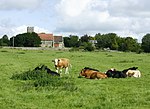Byne House
Georgian architecture in WiltshireGrade II* listed buildings in WiltshireGrade II* listed housesHouses completed in 1755Houses in Wiltshire ... and 2 more
WarminsterWiltshire building and structure stubs
Byne House is a Grade II* listed house at 40 Church Street, Warminster, Wiltshire, England. It was built in 1755 for the clothier John Wansey, and is an example of the wealth that accrued to the area from the wool industry. It was later the home of the headmaster of Warminster School. The house was badly damaged by fire in 2007. The nineteenth century railings outside the house are grade II listed.
Excerpt from the Wikipedia article Byne House (License: CC BY-SA 3.0, Authors).Byne House
Ash Walk,
Geographical coordinates (GPS) Address Website Nearby Places Show on map
Geographical coordinates (GPS)
| Latitude | Longitude |
|---|---|
| N 51.2064 ° | E -2.1888 ° |
Address
Warminster School
Ash Walk
BA12 8PZ , Warminster
England, United Kingdom
Open on Google Maps









